1967 French Grand Prix race report: Brabham conquers Le Mans
Jack Brabham comes out on top at the newly formed Le Mans Bugatti Circuit after more mechanical failures for Lotus
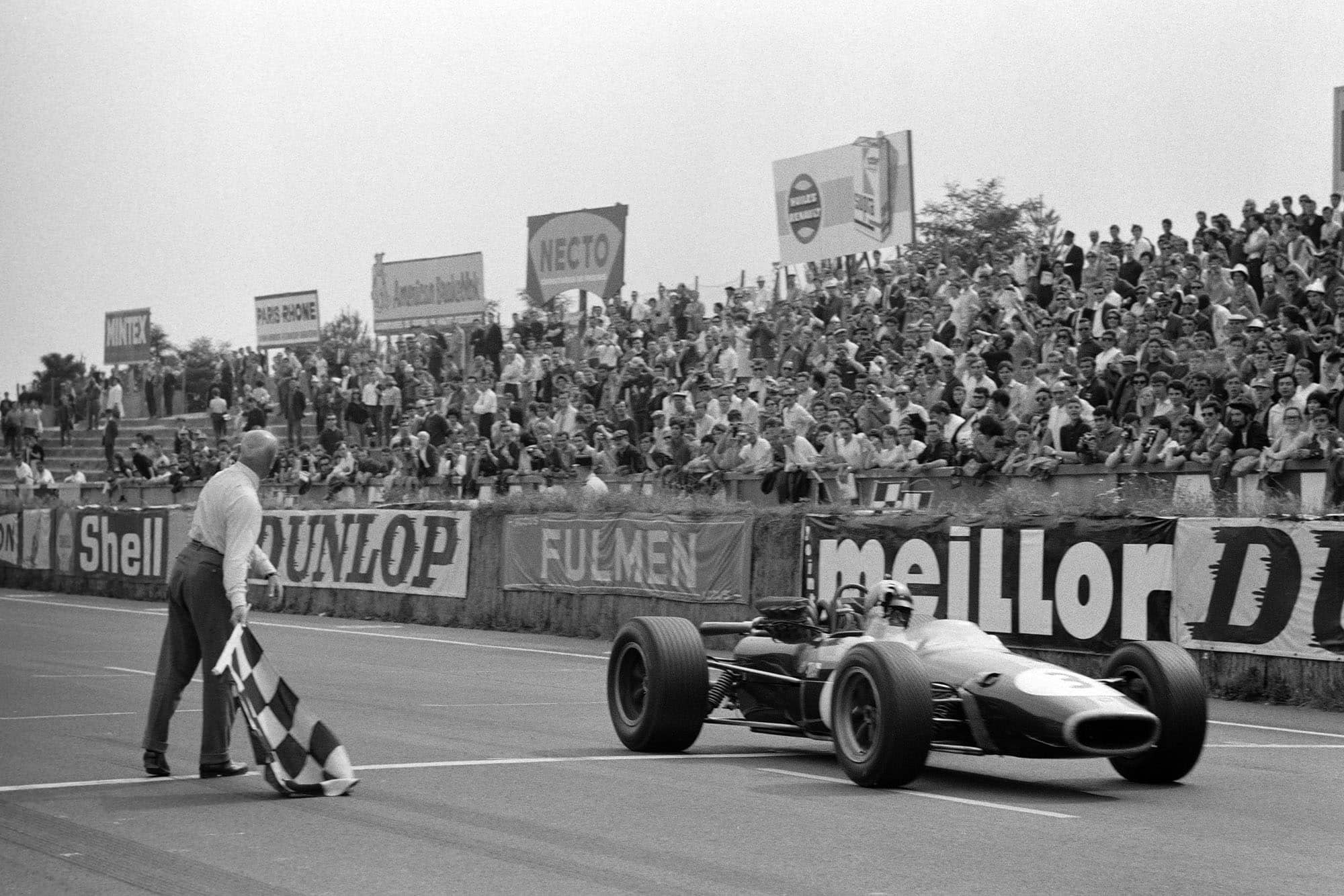
Jack Brabham was the fifth different winner in five races
Motorsport Images
It was the Automobile Club of France who started Grand Prix racing in 1906 and set the standard for this form of competition to be the pinnacle of driving and racing-car construction. The Grand Prix de l’Automobile Club de France has always been held in high esteem and has provided some memorable moments of Grand Prix history, though occasionally it has lapsed slightly, like all races with a long and varied history. This year the Grand Prix de l’ACF not only lapsed, it stumbled and fell.
Great friends with the AC of France are the members of the Automobile Club of the West, who own and run the Le Mans 24-hour race, and last year they started a racing driving school on a 4.422-kilometre circuit they built in the pits and car park area of the famous Circuit of the Sarthe and called it the Bugatti Circuit, in memory of the famous car manufacturer.
This circuit uses the pits and start area of the 24-hour circuit, runs round the right-hand climb, under the Dunlop bridge and down to the Esses, whereupon, instead of heading off for Tertre-Rouge it hairpins right into the vast car park, does two more hairpins joined by short straights, crosses over into another car park where it does an artificial ess-bend, and rejoins the main pit area with a very slow right-hander.
“The famous French Grand Prix was being dubbed “The Grand Prix of the Car Parks”
The well-surfaced road is lined with sand, like everything at Le Mans, and the corners are marked by old tyres sunk into the ground. A driving school circuit maybe, but not a Grand Prix circuit by European standards, or even by British standards, yet the Le Mans club persuaded the ACF to hold their famous Grand Prix on the Bugatti circuit, when Reims, Rouen and Clermont-Ferrand are available.
Had the proposition been to hold it on the big circuit of the Sarthe, the famous 24-hour circuit, there would have been no objections, but before it took place the famous French Grand Prix was being dubbed “The Grand Prix of the Car Parks.” As if in sympathy the entry dwindled before practice began and nearly died before the race finished.
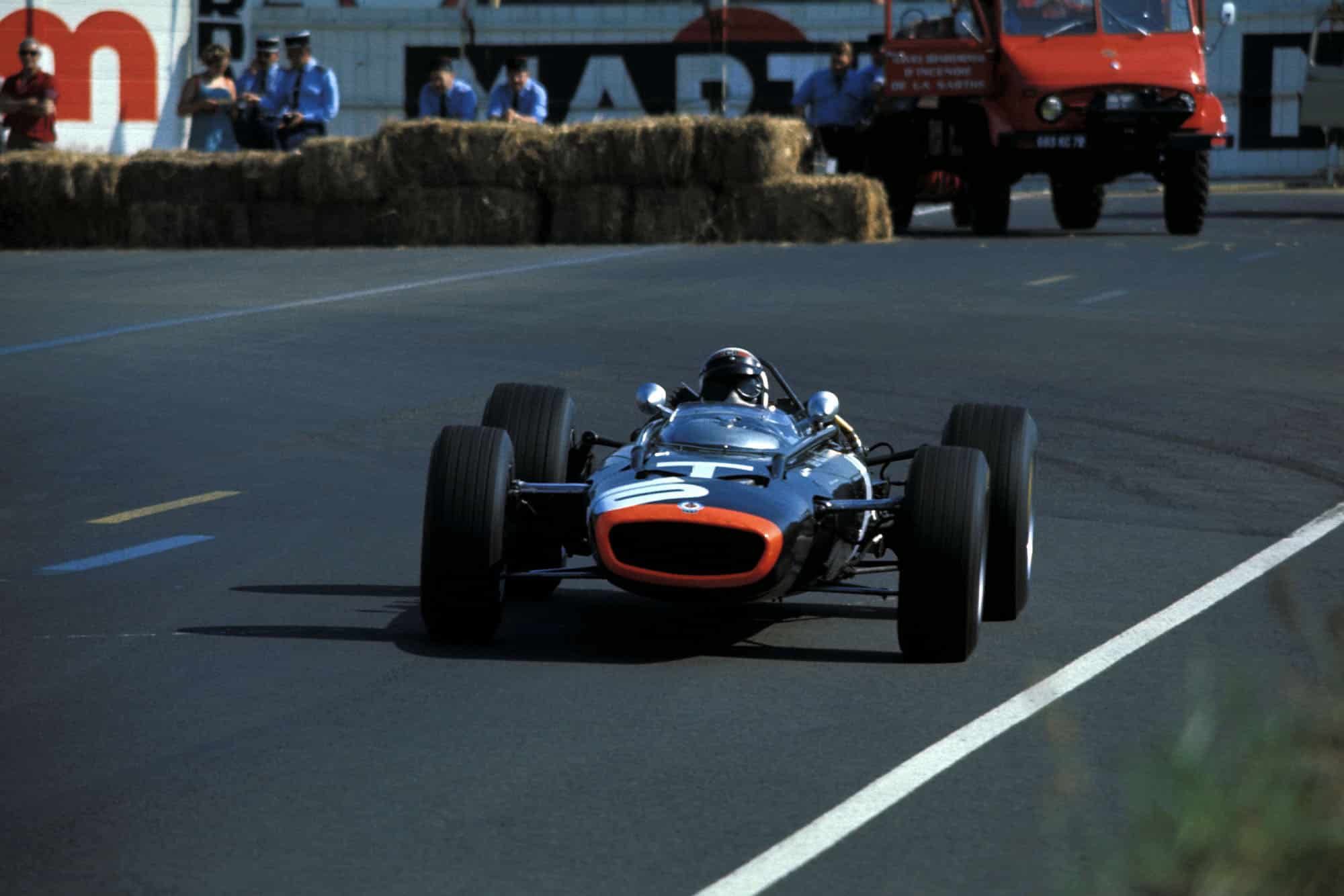
BRM brought both their old P261 and their new P83 H16 car, seen here driven by Stewart
Motorsport Images
With Parkes still in hospital and Scarfiotti losing interest since seeing the Spa accident, the Ferrari team was reduced to Amon, who had the two 1967 cars to choose from. Surtees was reduced to zero, his one Honda entry being forfeited due to lack of engines and a competitive car.
Brabham and Hulme both had 1967 Brabhams with the latest Repco V8 engines, Clark and Hill had the Lotus 49 cars of Team Lotus, Gurney had his titanium Eagle-Weslake V12 and entered the first of the V12 Eagles for McLaren to drive. Stewart and Spence were entered with H16-cylinder BRM cars, and Irwin had Parnell’s V8-cylinder Tasman BRM.
The Cooper team were as at Spa, with Rindt in the 1967 car, and Rodriguez in a modified 1966 Cooper-Maserati V12. The privately-owned cars were those of Anderson (Brabham-Climax 4-cyl), Ligier (Cooper-Maserati V12) and Siffert with Rob Walker’s Cooper-Maserati V12.
When the vast pit, grandstand and paddock area was opened up for the Grand Prix “circus” to entrench and begin practice, it was rather like putting the whole mechanism of London Airport into operation in order that someone could land a Piper Cub aircraft!
Qualifying
The sun was unbelievably hot and fuel systems and cooling systems were suffering, as the circuit involved a series of stops and starts, and no-one showed a great deal of enthusiasm for serious practising and the public did not even bother to come and watch.
The Team Lotus transporter was held up at the customs at Dieppe so Clark and Hill had to watch everyone else getting hot, and BRM were embarrassed for Chris Irwin was lapping faster in the 2-litre V8 car than the two works drivers in the 3-litre cars.
“No-one showed a great deal of enthusiasm for serious practising and the public did not even bother to come and watch”
McLaren was being very careful not to ruffle the Eagle on his first public outing into it, and the two Brabham drivers were making hay while the sun shone and Lotus were away.
The second day of practice was not much more exciting, even though the Team Lotus cars arrived, and the most enthusiastic followers of Grand Prix racing found it hard to enthuse over the Bugatti circuit, especially as the cars passed the pits so slowly that team managers could almost talk to their drivers.
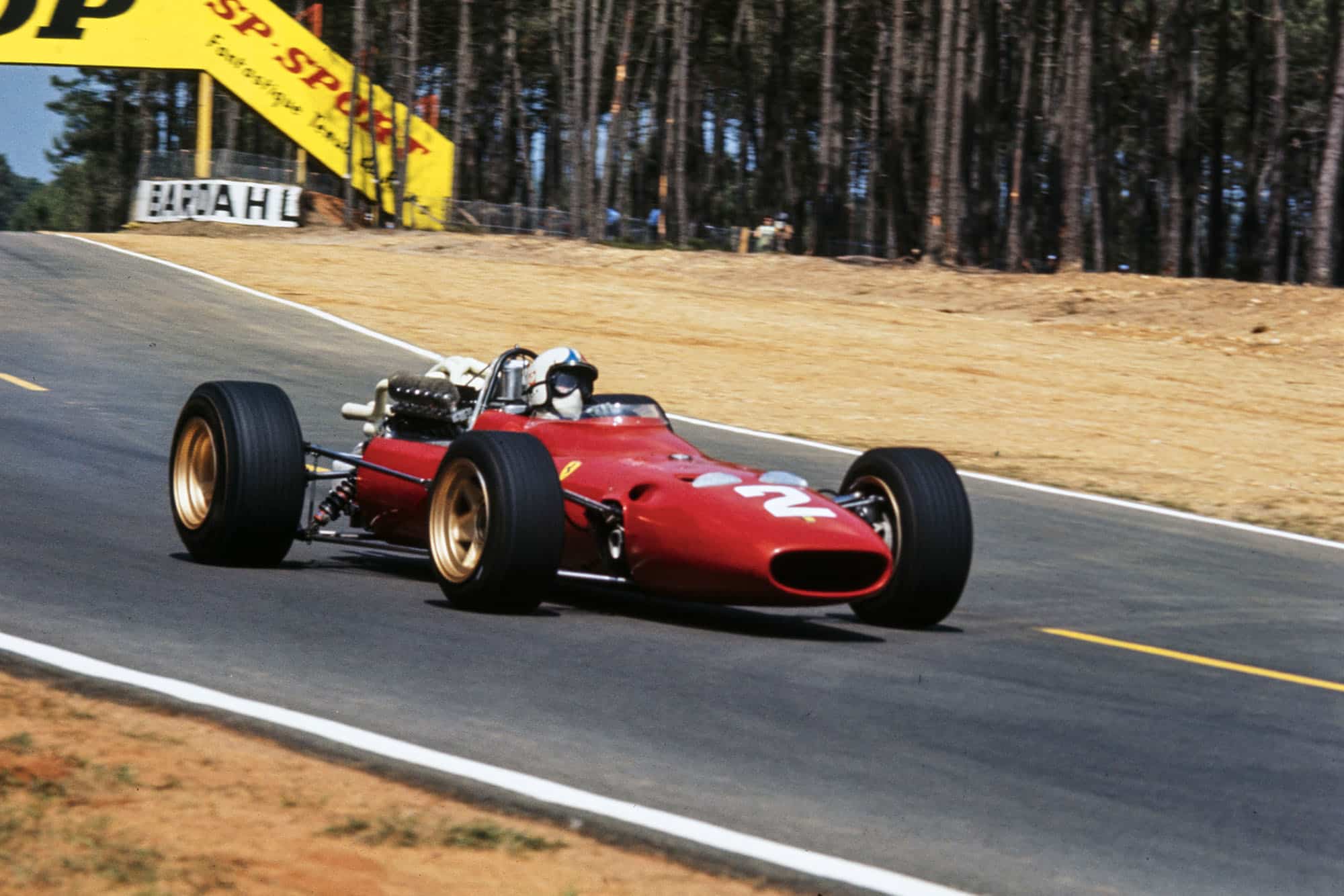
Amon was the only Ferrari entered
Motorsport Images
Those who were used to Le Mans cars passing the same pits in a crash of sound and fury at 160-165mph found the present situation, with Grand Prix cars accelerating past at 80-90mph dreadfully dull; and it did not help matters that there was all the organisational flap, the police, the rules and regulations for the 165mph passing.
Some of the drivers and teams had been through all this before, as a Formula Two race was held last year, but with this being the first Formula One visit, and the last if justice prevails, there were no standards at which to aim.
Not unnaturally most people went faster on the second day of practice and it was amusing to see that BRM had snatched the V8 Tasman car away from Tim Parnell and Irwin, to give it to Stewart; and given them an H16-cylinder car in return. It was even more amusing when Stewart failed to equal the time set up by Irwin the day before, and Irwin improved on Stewart’s time with the 16-cylinder car. (What a lot of old proverbs spring to mind.)
Just when nearly everybody had been brain-washed into accepting the 3-litre Cosworth engine as a Ford design it started misfiring in both cars, and it was Keith Duckworth, Colin Chapman and the Team Lotus mechanics who were trying to sort out the trouble.
It seemed pointless to ask what the trouble was, for if they had known they would have cured it. It was either the injection system or the ignition system or the fuel system, or a combination of all three, but whatever it was it remained uncurable on Clark’s engine and just as practice was finishing it cured itself on Hill’s engine, and with it singing merrily on all eight cylinders he recorded fastest practice lap with very little effort. Brabham and Gurney had been dominating the practice times and Hill beat them both before he was fully aware that the Lotus was running properly at last. Clark was fourth fastest with an engine that never did run correctly.
Race
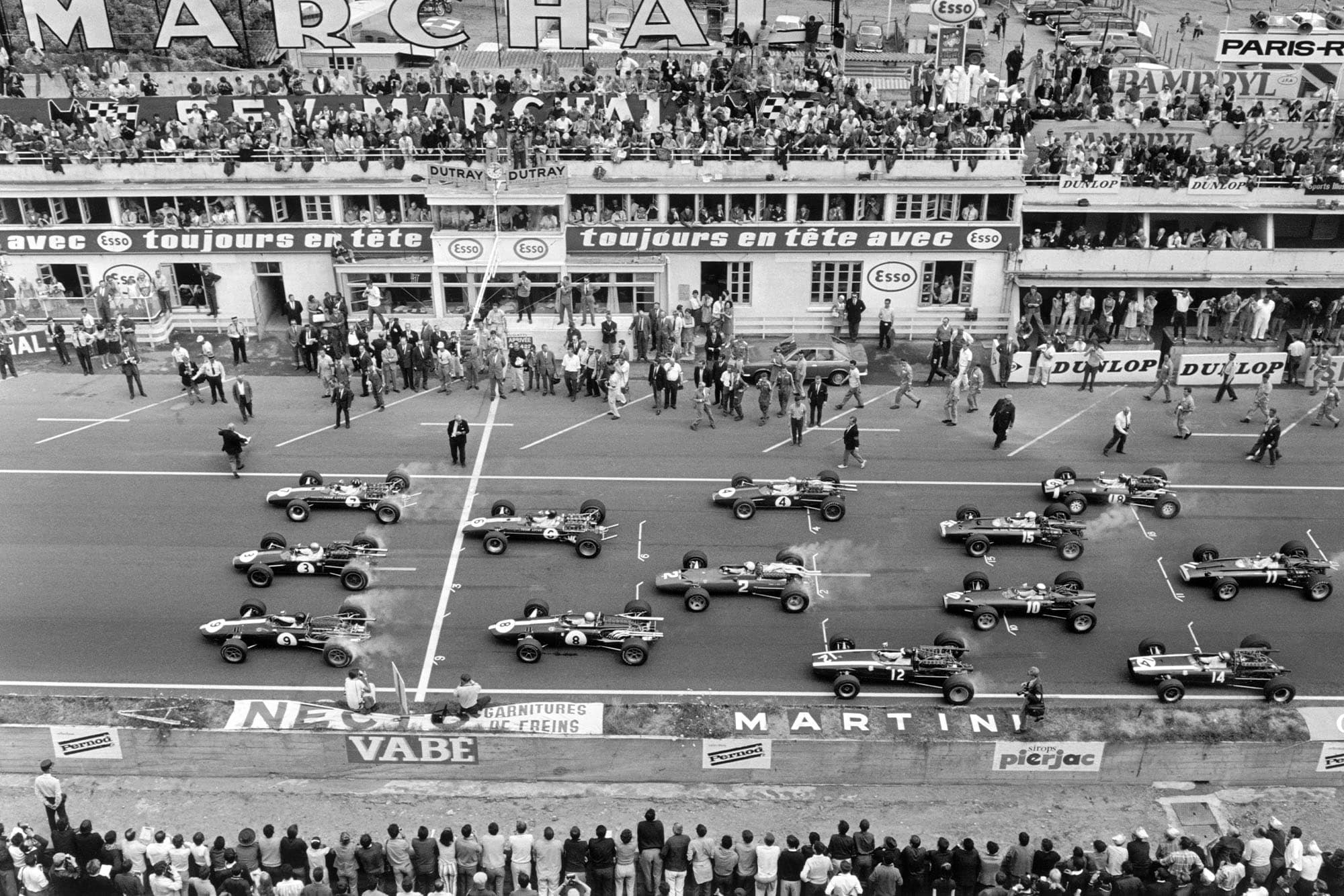
Wheel-spin ensues as the cars pull away from the grid
Motorsport Images
The pit area at Le Mans is very long indeed, providing, as it does, 24-hour facilities for 55 cars, so that 15 cars were rather lost and the 20,000 people who turned up on race day looked very sparse in an area that normally accommodates 200,000 people.
For some strange organisational reason the start-line assembly area was at the lower end of the pits and the pits in use by the Grand Prix teams were at the upper end, and to make life really difficult all the transporters had to be parked at the lower end of the paddock.
A warm-up lap was to be allowed and when the organisers requested that all the cars should be wheeled right down to the lower end before starting off there was a near-riot and most drivers just got in and drove away.
The “dummy grid” was formed up so far from the starting line that few drivers could see the starter waving them to move forward, and it was more by luck than judgement that the fifteen competitors were ready to go when the French flag fell.
Just before lunch there had been a heavy rain shower, but by 2pm when the race over 80 laps began, all was dry and set fair, a haze keeping the real power of the sun away.
Hill led the pack away and was just ahead a Gurney, Brabham, Clark and Amon the first time round the car park! Then Brabham got in front and meanwhile Clark was finding out about the circuit with 400bhp available for the first time, having had the engine unit changed overnight for one that really worked, the practice trouble being the fuel pump, which is part and parcel of the complete power unit.
“Hill led the pack away and was just ahead a Gurney, Brabham, Clark and Amon the first time round the car park!”
By lap 3 he was third, by lap 4 he was second, and he took the lead on lap 5 and began to motor away from everyone except Hill who followed him through as he went by and the Lotus 49s were first and second on lap 7 and proceeded to draw away from everyone else, running nose-to-tail, the way Fangio and Moss used to do in 1955 with the W196 Mercedes-Benz cars.
Brabham was holding third place and keeping ahead of Gurney, as practice indicated he would do, and they were followed by Amon and Hulme in close company, as at Zandvoort, then Rindt, McLaren, Rodriguez, Stewart (in the 2-litre V8 BRM), Spence, Siffert, Anderson, Irwin and Ligier.
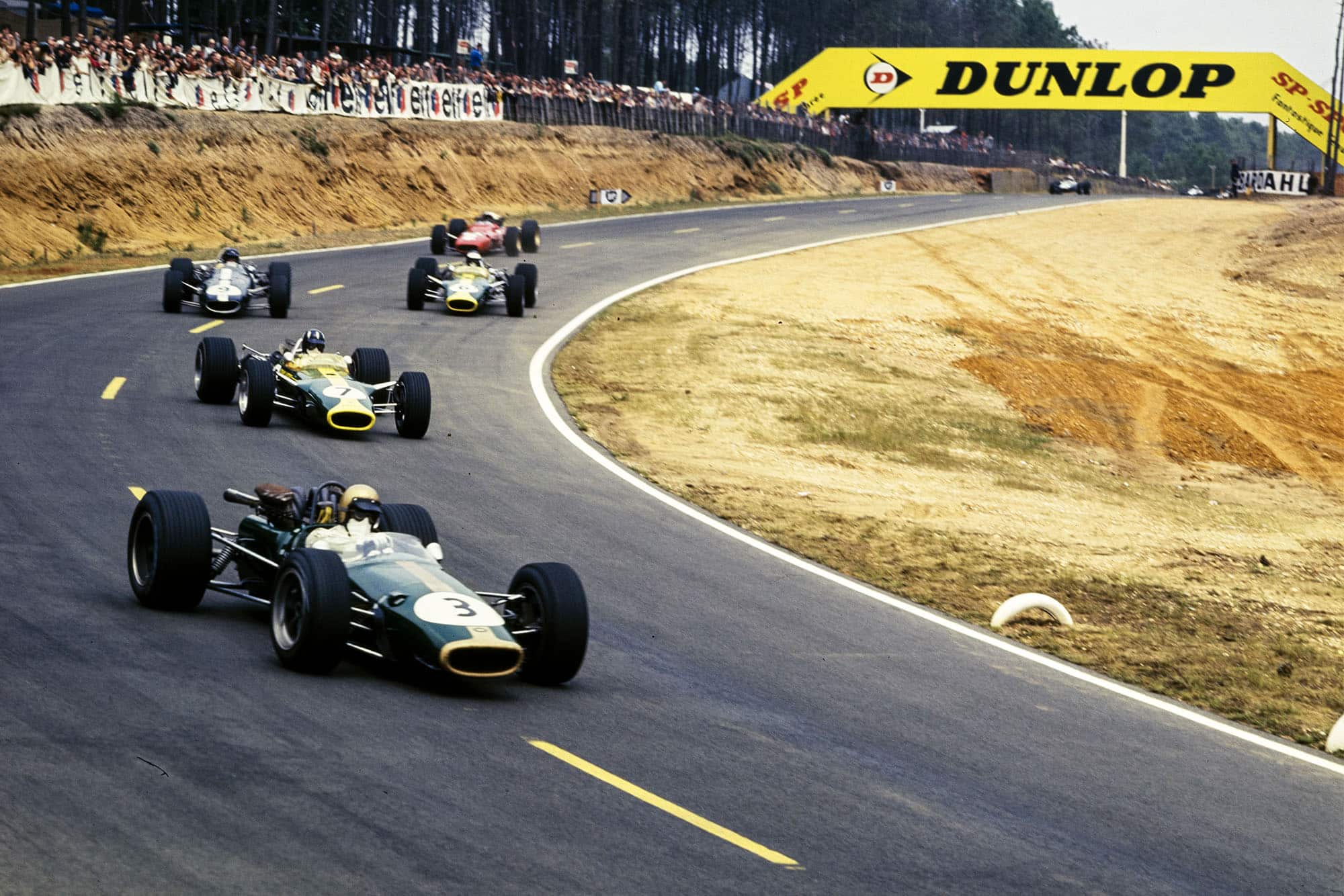
Brabham led early on
Motorsport Images
As the two green and yellow Team Lotus cars pulled out a commanding lead they looked most impressive and sounded superb, and on lap 11 Hill went in front, but they remained nose-to-tail. Spence had already come to rest with a broken output shaft from the differential unit to the inboard universal joint on one drive shaft, and Hulme had lost the wooden knob off his gear-lever and was changing gear with the metal rod of the lever.
Rindt had a wild spin in his works Cooper-Maserati which dropped him from seventh to 10th place, and McLaren’s Weslake V12 engine did not seem to have the power it started out with.
At the end of lap 14 Ford faces fell in the Lotus pit and the Lotus lads did not look happy, for Clark appeared on his own and No 7 Lotus was coasting to a stop round the back of the pits. Most of the teeth on the ZF pinion and a lot on the crown-wheel had broken and there was no more final drive.
Hulme had passed Amon, when he got used to changing gear with a threaded rod, and apart from Rindt, recovering ground after his spin, nobody looked like catching or passing anyone. By 20 laps, or quarter distance, Clark was well out of sight round the Dunlop Bridge bend before Brabham and Gurney came into view, the gap between Clark and Gurney being 15sec.
As Clark completed his 23rd lap there was consternation for he headed for the pits to report a nasty noise in the ZF final drive unit. He was not wrong and this left Brabham with a precarious lead over Gurney, and Amon had just re-passed Hulme, so the Ferrari was now third.
Anderson had stopped out on the circuit when a small part in his ignition distributor broke, and Ligier had spent some time in the pits having his accelerator control repaired. Hardly had we got over the loss of the second Lotus, than McLaren stopped to say that the Weslake engine was going really flat. It had been obvious for some time that he did not have 400bhp he could not out-accelerate the Cooper-Maseratis, and it was discovered that the tongue-drive to the ignition trigger disc was shearing, retarding the ignition, so the car was withdrawn.
Although Gurney could not get by Brabham, even had there been room on this “Mickey Mouse” circuit, Brabham was not getting away, and there seemed to be a stale-mate. They were over half a minute ahead of Amon and Hulme, who were still racing each other, and on lap 30 Hulme got his Brabham-Repco V8 in front of the Ferrari. Rindt had rejoined his team-mate and they were urging each other on, leaving Stewart way behind, the 2-litre BRM about to be lapped by the leaders, Siffert and Irwin having already been lapped.
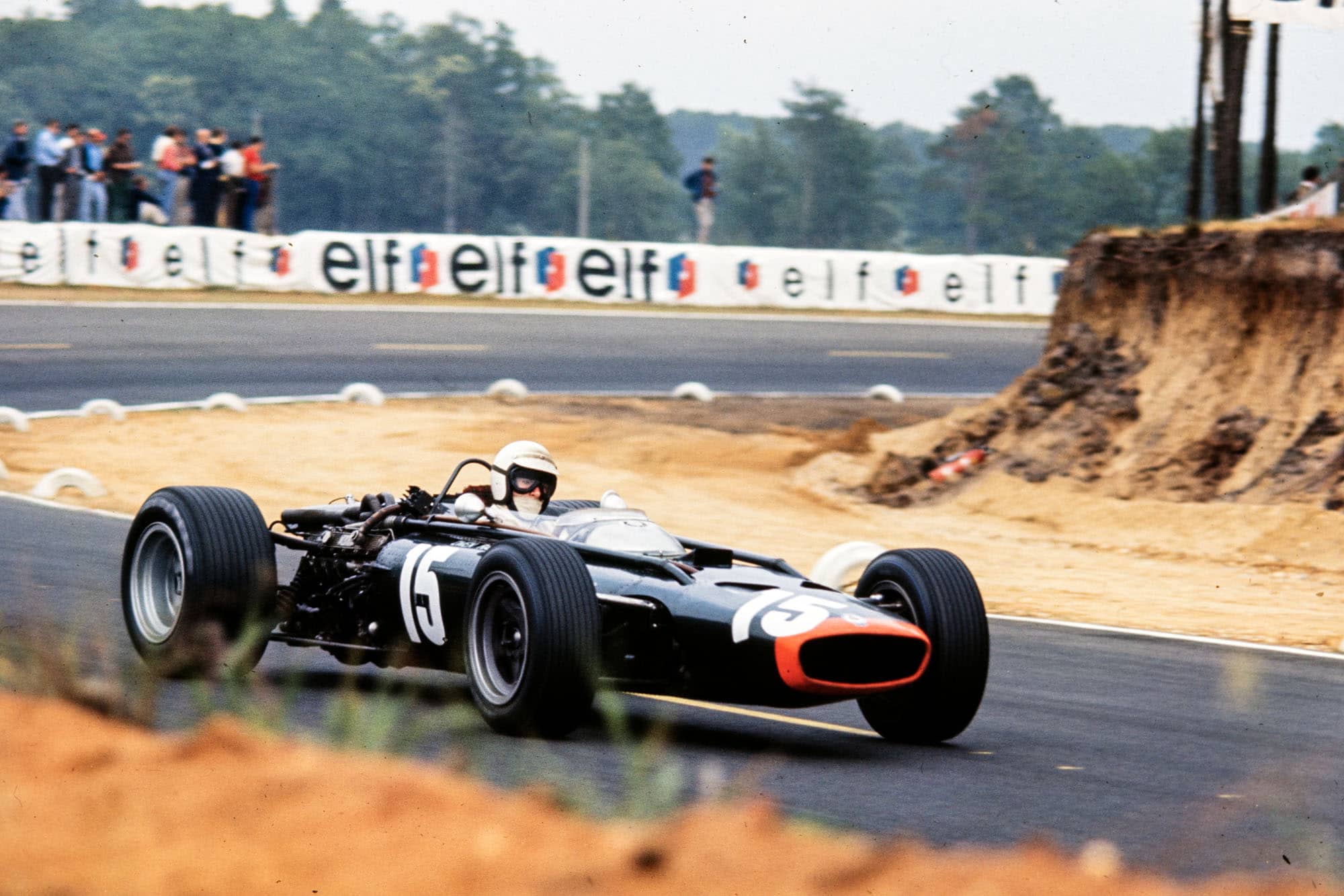
Chris Irwin classified 5th in spite of an engine failure
Motorsport Images
On lap 34 a piston broke in Rindt’s Maserati engine and there was a nasty mess inside, and he coasted to a stop, while on the previous lap Stewart was caught and passed by the leading two cars.
At 38 laps Gurney’s Eagle suddenly lost a lot of ground and he went by pointing over his shoulder to the engine; on the next lap the engine was misfiring badly and even worse on lap 40, exactly half distance. Next time round he only just got to the beginning of the pit area, and there he retired with a broken union in the fuel system on the injection unit.
“At 38 laps Gurney’s Eagle suddenly lost a lot of ground and he went by pointing over his shoulder to the engine”
A small pipe between the injector unit and the pressure release valve system had fractured at the union itself and all the injection pressure was lost, there being no means of effecting a repair. This left Brabham in a comfortable lead over his team-mate, who was no longer being harried by the lone Ferrari, even though it was still there.
At 47 laps Rodriguez coasted into the pits with fuel in the cockpit from a broken pipe between the metering unit and the pressure gauge on the instrument panel. Due to the uphill pit area the Cooper-Maserati stopped short of the pits and Cooper mechanics ran down to Rodriguez to find the trouble. They undid the pipe from the metering unit and fitted a blank olive in the union, and Rodriguez was back in the race, the Maserati engine sounding as good as ever, but the stop dropped him down to last place, apart from Ligier who was way behind after two long pit stops.
While all this was happening Amon came to a stop out on the circuit when his accelerator control broke, down by the foot pedal, so this left the two Brabham-Repco V8s in complete command of the race, with Stewart third, even though he was in danger of being lapped for the second time.
By three-quarter distance, or 60 laps, the very healthy Brabham-Repco V8s were cruising round, followed by Stewart in the V8 BRM and Irwin in the H16 BRM, for he had just passed Siffert’s Cooper-Maserati which had started to run badly as the battery was failing and the fuel pressure at the injection pump was falling.
Rodriguez was four laps behind Brabham and actually lapping faster than the leader, and last, but still running, was Ligier, so we had seven survivors. Things stayed this way until lap 69 when Irwin appeared with smoke pouring out of the back of the H16 BRM, from an oil leak dropping onto an exhaust pipe.
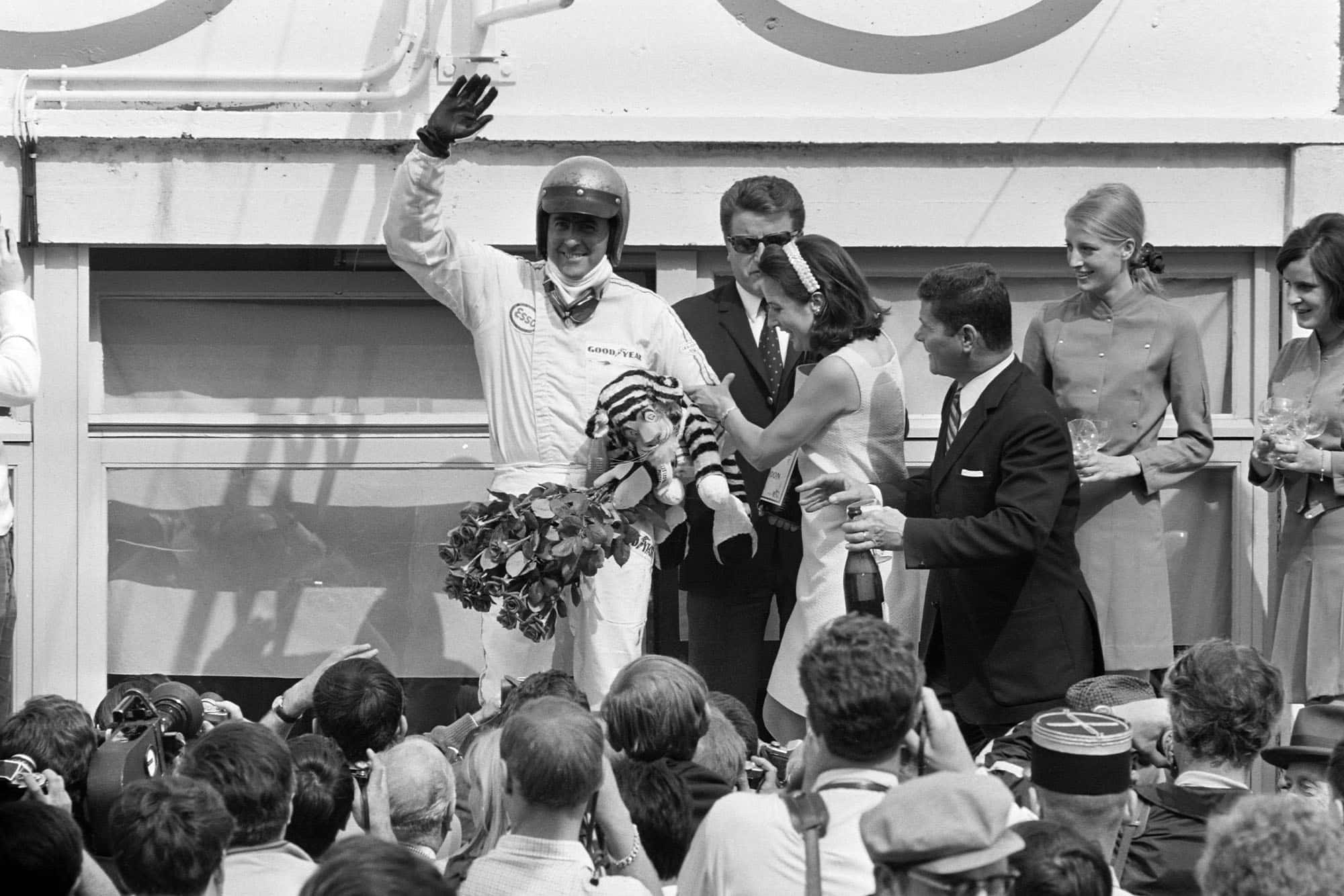
Esso tiger in hand, Brabham soaks up the adualtion
Motorsport Images
As the end of the race was in sight he was told to keep going and he nursed the car along until the last lap, when the engine was out of oil, and as it started to “rattle” he switched off and stopped just half a lap from the chequered flag. As Brabham had finished the 80 laps Irwin was classified, but his stop meant that the limping Siffert was able to retake fourth place.
Everyone seemed relieved that the whole farce of a Grand Prix on a driving school circuit was over, and the only happy people were the Brabham team, but they would rather have won a better race.
Le Mans Murmurs
- And they called that the Grand Prix of the Automobile Club of France, the originator of all Grand Prix racing.
- The official programme carried no map of the circuit, not a list of race officials; very odd.
- What a lot of spectators, “hangers on” and drinkers seemed to think they were at the 24 Hours of Le Mans. It was all over before a lot of them had had their fill.
- There were more spectators for the 24-hour race practice than for the French GP.
Notes on the Cars at the French GP
The two Ferraris were both 1967 models, chassis numbers 0003 and 0005, with the 36-valve V12-cylinder engines with the central exhaust layout, and though a short blunt radiator cowling was tried in practice, the normal long one was used for the race. Amon had his choice of the two cars and used 0005 for the race.
Brabham drove the 1967 car he first tried out at Zandvoort, number BT24-1, everything being to the latest specification, and Hulme had an identical car, BT24-2, that should have been ready for the Belgian GP but time ran out. Both cars were using the 1967 Type 740 Repco-Brabham V8 engines, these having the Repco-designed and built crankcases, which are more rigid than the GM ones used last year and have wet cylinder liners and cross-bolted main bearing caps.
The new cylinder heads have the valves vertical, in line with the cylinder centre-line, instead of the 10-degree inward slope used last year, which has necessitated re-positioning the camshafts and making the engine a little bit wider, but the camshafts are still driven by duplex chain. Inlet and exhaust ports are all within the centre of the vee of the engine and the unit is some 30lb lighter than last year and gives 325-330bhp, with a wide torque range.
The two Lotus 49 cars were 49/1 and 49/2 as used at the previous races, but incorporating numerous modifications and improvements. After the trouble in the Belgian GP a new type of clutch was in use, needless to say, and in order to make the 400bhp more controllable a revised throttle linkage was fitted.
The power appears to come in rather suddenly, which is no problem on a high-speed circuit where you can use the maximum all the time, but on a slow circuit more control is desirable, so both cars were fitted with a “progressive” movement system. The windscreen shape has been improved and on the instrument panel, which is now rubber mounted, is a control for the driver to alter the adjustment of the brake pedal balance-bar, so that he can vary front-to-rear braking ratio at will.
Both cars are now technically “legal” as they have tubular structures bolted on to the rear of the ZF gearboxes to form the legal extremity of the car. This is because there is an obscure FAI rule that says the exhaust pipes shall not extend more than 10” beyond the rear of the car. T
he long tailpipes of the Cosworth V8 engine are well over this limit if it is measured from the end of the gearbox. The tubular “legalisors” bolt to the gearbox and define the extremity of the Lotus 49! This is a dodge that has-been employed on most Formula Two cars this season, for the 4-cylinder Cosworth-Ford engine also uses a very long tail-pipe.
The two Anglo-American Eagle-Weslake V12 cars were similar in specification, Gurney having the very light one, number 104, which first appeared at Zandvoort. McLaren drove number 102, which was the first Eagle to have the 12-cylinder engine and which made its debut at Monza last year.
In the first practice the engine broke an oil scavenge pump driving gear, and luckily AAR had a spare engine. Gurney’s retirement due to a broken fuel pipe union was probably a result of a high-frequency vibration being transmitted to this short rigid pipe and would indicate the need for flexible piping in future.
McLaren’s retirement was more obscure though not entirely new to the Weslake engine. The Lucas transistorised ignition is usually triggered off by segments on the flywheel passing between a pair of pick-up terminals, but the flywheel arrangement on the Weslake engine prevents this system being used, as it does on the H16 BRM engine, so an external trigger disc is used. On the Weslake engine it is mounted on the rear of the right-hand exhaust camshaft, out in the open air, with a tongue drive front the shaft.
This disc with its 12 contact, segments acts rather like a small flywheel on the end of the camshaft and is naturally subject to the sudden accelerations and decelerations of the engine, imposing heavy stresses on the drive. Having the ignition trigger disc on the camshaft also means that it is operating at half the crankshaft speed when starting, which can be a disadvantage. The tongue drive failed on McLaren’s engine.
The BRM team arrived with two early H16-cylinder cars and the latest slimmer and lighter one, recognisable by its efficient looking roll-cage round the cockpit, rather than the usual flimsy crash-bar loop.
Parnell had the V8-cylinder Tasman car he has been campaigning with Irwin and Courage, but when it was seen to be going faster than the16-cylinder cars it was taken away and given to Stewart, and Parnell’s driver had Stewart’s old-type 16-cylinder, chassis 8302, Spence retaining the 16-cylinder, chassis 8303, and the new one was not used for the race.
The Cooper team were still making do with the old V12-cylinder Maserati engines, as the promising-looking 3-valves-per-cylinder engine that made a brief appearance at Monaco is still lacking reliable horsepower.
For the race Rindt drove the lighter 1967 car, with Hewland gearbox, using cast magnesium Cooper wheels on the front and the new fabricated disc wheels on the rear, while Rodriguez used a 1966. car. The modified 1966 car, with inboard rear brakes, was there as a spare.
The remaining three entries were the private cars of Anderson, Ligier and Siffert, suffering, like all private owners in racing, from lack of support by the parent factories, as is inevitable while the factory teams are seldom as advanced as they would like to be.
Photo Caption: Repco-Brabham V8. — The neat and compact Type 740 racing engine built in Australia for use in the Brabham Formula One cars. The single overhead camshaft on each cylinder head is chain drivein and operates vertical valves. This view shows the rear of the engine.
Trophy of the Sarthe — Formula Three
Two Heats of 23 laps and Final of 30 laps
As is becoming a habit in French Formula Three races the works Matra team dominated the whole affair, which is not surprising when you consider that all the opposition comes from small garage concerns or private owners.
The Matra-Fords are not only well prepared, run as a serious racing team, but are well driven by Pescarolo and Jaussaud, and if one fails, as the latter did in the Final, the other is always there to keep control.
In the Le Mans event Pescarolo could do no wrong, winning his Heat and running away unchallenged in the Final. The Felday team of Westbury, Bell and Pike did their best to provide opposition, being well placed in their Heats, but they got tangled up with one another in the Final in their efforts to stay with the works Matras. Stiller drove a good race in the Final to pull up from the end of the field alter a spin on the opening lap, to fourth place overall.
